Let Students Use Notes on Class Tests & Quizzes
A MiddleWeb Blog
By Amber Chandler
If you were a student in my classroom in 2001, you most certainly would have been required to memorize the following formula:
- Last name, first name
- Title of Book
- City of Publication
- Publisher
- year of publication
Who didn’t need to know the correct method for appropriately citing a resource book using MLA style?

This was true even in 2001, when my students could have easily used their book to look up the appropriate way to cite a source. Now, in the era of pervasive internet access, it’s glaringly obvious that we need to reassess what we make students memorize when they can look up almost anything they need to know.
Our bigger task is to help them sort through the mountains of information everywhere and use it to their advantage.
Before I explain my position, let me throw in this one caveat: I’m not good at math (I know, I know, I’m supposed to have a growth mindset, but I think that muscle atrophied after college algebra). I certainly don’t know how to teach mathematics, so I won’t speculate about what would work for math teachers. However, I’ve come to believe that allowing students access to their notes for most quizzes and tests is the best way for students to learn.
You’ll notice that I don’t say the open notes approach is the best way to learn to take tests or prepare for SATs or ACTs. I believe that those tests are a genre unto themselves and should be taught as such, but that’s another blog for another time.
Standardized testing aside, there are three important ways that open notes benefit students.
1. Using Resources
I allow students either notecards (usually for quizzes or smaller assignments) or one sheet of paper, back and front. They are allowed to write down any information that they deem important. Obviously, creating the notes themselves is an opportunity to teach students how to make decisions about what is important and what isn’t.
Here’s the explanation I gave my students the first time they were allowed to use notes this year for a quiz on a short story we were reading:
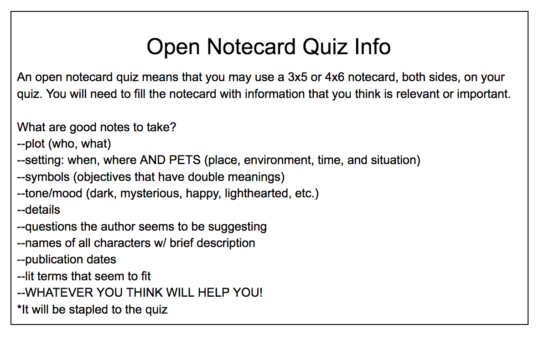
If the Resource Group member doesn’t know, they could then Google the question. I was fascinated to find out that many of my students believed that Googling the answers in this case was cheating.
That conversation really impacted my thinking about how I will teach exactly what I mean when I say “using resources” in the future. My students enlightened me on this topic, and next year I will spend a few days overtly talking about the many resources students may use.
Finally, we talked about having a conversation with an adult, whether it be me, another teacher, or a family member. As they weigh out what to give valuable “note space” to, the act of taking notes becomes an exercise in learning the material.
2. Taking Notes
When I first started telling my students that they’d be allowed to use their notes on a quiz, it was the students with the highest averages whose hands shot up. How many notes? Could they type them? Will they be collected?
After I walked these kiddos through the expectation, it became evident that there was also a segment who didn’t know a thing about what to write down. For better or worse, after years of guided notes, many students don’t have any idea how to decipher which information is important and which isn’t.
In addition to taking about what to write down, I gave them some hints about how to write it down. Using color coding, bullet points, subheadings, and lists were among the strategies my students came up with in their Resource Groups.
I wanted them to really think about why they were collecting notes in the first place. We had a discussion using Google Classroom about why I allowed students to use notes. Most of the answers pointed to the fact that I wanted them to do well – which, of course, is true – but it’s also a great classroom culture builder. We are supporting the social and emotional needs of students when they believe that their teachers have their best interests in mind.
Here’s what some of the more surprising answers said:
Ella nailed it. And Jack, particularly, caught my attention because he was echoing something I’d said offhandedly in class. I’d said, “This is the important skill, right? Out in the world, when do you have to solve a problem without any help? We can almost always look things up at the library or on the internet, talk to our friends or family. It’s not very often we have to come up with answers all on our own.”
Jack’s response was validating to me, but also it reminded me that I should always bring what I’m teaching back around to the real world implications.
3. Pinpointing Gaps
After I collected the first “open note” quizzes, I learned the most valuable reason to allow students to use their notes.
When they handed in their quizzes, I had students staple their notes to them. As I graded, when a student didn’t do as well as I’d expected, I was able to crosscheck whether the students’ notes were incomplete or inaccurate, or if the student was having problems even transferring what they had on their notes to answer the questions. Without fail, the data provided to me by the notes was as important as the quiz grade itself.
For example, one of my students had meticulous notes, but had really bombed a section of the quiz. When I looked more closely at what she turned in, it was clear that she was missing that entire section of notes. I looked at her attendance, and sure enough, she had left early that day.
I was then able to have a conversation with her about a real life skill: when you miss school (or work, later in life) you need to make sure that you find out what happened. It doesn’t seem like an “Ah Ha” moment to an adult necessarily, but when I was able to show her, to really pinpoint it for her, I was confident that the lesson she learned would impact the way she handles absences in the future.
I collected another datapoint that applied more generally across all of my students. It told me something about my teaching. The section that most students struggled with was the literary vocabulary.
We’d practiced identifying similes, metaphors, hyperbole, imagery, dialogue, personification, foreshadowing, flashbacks, and symbols. I noticed that many students missed personification. When I glanced at the students’ notes, I found that most of them had only written down one example, even though I’d given several.
I’m still not sure why – and I’ll have to go to the source (my students) to figure it out, but I do know that when my attention is turned to these gaps, my teaching will improve.
Open notes have multiple advantages
Here’s the rule of thumb: The next time you are giving a quiz or test, ask yourself what needs to be memorized, ostensibly stored in their long term memory. If it is not specifically something that they will need to retrieve on many future occasions, allow students to use their notes.
You’ll see your students work hard to complete notes – as well as collaborate and gain more savvy about using resources. And you’ll mine the data from the notes that improve your teaching as you learn more about your students’ needs.
Amber Chandler teaches 8th grade ELA at Frontier Middle School along with courses at Canisius College. In addition, she is an NBCT and a trainer who leads workshops and blogs for ShareMyLesson, AMLE and AFT. She serves as president of the Frontier Central Teachers’ Association. Amber was the AMLE 2018 Educator of the Year and a finalist for New York State 2022 Teacher of the Year. Her Flexible Classroom articles for MiddleWeb are here.
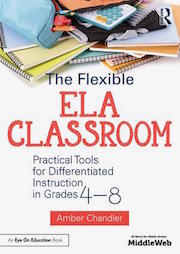

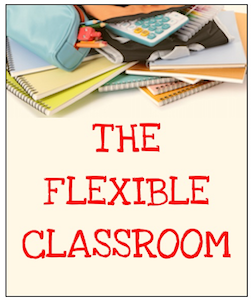
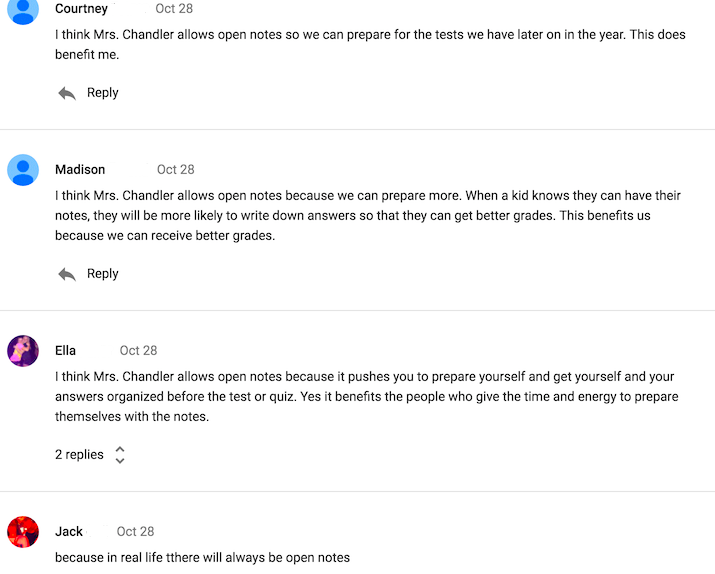
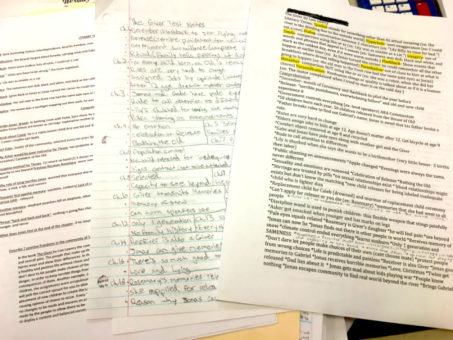

































Agreed and I’m a Math Teacher that has taught other subjects after 18 years in business!
Excellent article! I thoroughly enjoyed reading it and you sharing your insights. I especially liked the section of pinpointing gaps, benefit #3. Thank you for sharing.
Carla Keeter–I’m happy to hear that a “math person” doesn’t think I’m nuts! Thanks for sharing that with me.
Great article,Amber. I started doing this in my middle school math classes this past year. At first the students thought it would allow them easy A’s, but soon realized, like some of your students, that it was really a tool to assist them in preparing for the assessment. Looking forward to exploring your blog. Happy Summer!
Thanks! I was just explaining this to my new students, and I could see they understood that I really wanted them to do well.
Love the article Amber. I am a middle school science teacher and allow my students to use their notes on most tests and quizzes. I love the idea of having students make their own note cards or sheets for the test instead of what I currently do. Unfortunately I am probably the only teacher at my school that allow students to use notes on tests and quizzes. I don’t think teachers really know how much this practice can tell them about student learning and their own teaching